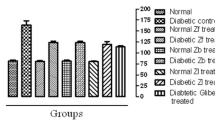Abstract
The present study was carried out to evaluate the antidiabetic effect of T. arjuna stembark extract and to study the activities of hexokinase, aldolase and phosphoglucoisomerase, and gluconeogenic enzymes such as glucose-6-phosphatase and fructose-1,6-diphosphatase in liver and kidney of normal and alloxan induced diabetic rats. Oral administration of ethanolic extract of bark (250 and 500mg/kg body weight) for 30 days, resulted in significant decrease of blood glucose from 302.67±22.35 to 82.50±04.72 and in a decrease in the activities of glucose-6-phosphatase, fructose-1,6-disphosphatase, aldolase and an increase in the activity of phosphoglucoisomerase and hexokinase in tissues. However, in the case of 250 mg/kg body weight of extract, less activity was observed. The study clearly shows that the bark extract ofT. arjuna possesses potent antidiabetic activity.
Similar content being viewed by others
References
Trivedi, B., Mazumdar, J.D., Bhatt and Hemavathi, K.G. (2004) Effect ofShilajit on blood glucose and lipid profile in alloxan-induced diabetic rats,Indian J Pharmacol. 36(6), 373–376.
Bailey, C.J. and Day, C. (1989) Traditional plant medicines as treatment for diabetes,Diabetes care. 12(8).
Rajasekaran, S., Sivagnanam, K., Narayanan, V. and Subramanian, S. (2001) Hypoglycemic and hypolipidemic effects ofAloevera on experimental rabbits. Publication ofIndian Association of Biomedical Scientists. 41–45.
Tiwari, A.K., Gode, J.D. and Dubey, G.P. (1989) Effect ofT. arjuna bark powder on serum lipids and lipoproteins in hypercholesterolemic rabbits.Indian Drugs. 26, 664.
Tiwari, A.K., Gode, J.D. and Dubey, G.P. (1990) Effect ofT.arjuna on lipid profiles of rabbits fed hypercholesterolemic diet.Int. J. Crude Drugs Res. 28, 43–47
Pathak, S.R., Upadhyay, L., Singh R.H., Dubey, G.P. and Udupa, K.N. (1990) Effect ofT. arjuna on autocodial and lipid profiles of rabbits.Indian drugs. 27, 221–227.
Khanna, A.K., Chander, R. and Kapoor, N.K. (1996)T. arjuna an ayurvedic cardiotonic regulates lipid metabolism in hyperlipeaemic rats.Phyto Res. 10, 663–665
Shaila, H.P., Udupa, S.L., Udupa, A.L. and Nair, N.S. (1997) Effect ofT. arjuna on experimental hyperlipidemia in rabbits.J. Pharmacogn. 35, 1–4.
Ram, A., Lauria, P., Gupta, R.P., Kumar, P. and Pandsharma, V.N. (1997) Hypocholesterolemic effects ofT. arjuna tree bark.J. Ethanopharmacol. 55, 165–169
Kusumoto, I.T., Nakabayashi, T., Kida, H., Miyashrio Hattori, M., Namba, T. and Shimotohno. (1995) Screening of various plant extracts used in ayurvedic medicine for inhibitory effects on human immunodeficiency virus-I (HIV-I) protease,Phytotherapy Research. 9(3) 180.
Kaur, S., Grover, I.S. and Kumar, S. (2001) Anti mutagenic potential of extracts isolated fromTerminalia arjuna.J. Environ Pathol Toxicol Oncol. 20, 9–14.
Shaila, H.P., Udupa, S.L. and Udupa, A.L. (1997a) Hypolipidemic effect ofTerminalia arjuna in cholesterol fed rabbits.Fitoterapia. 68, 405–409.
Avinash, N., Laxman, S.M., Satwinderject, K., Iqbal, S.G., Renu, W. and Sunil, C.K. (2000) Growth suppression of human transformed cells by treatment with bark extracts from a medicinal plantTerminalia arjuna, in vitro cell.Dev. Biol-Animal. 36, 544–547.
Takahashi, S., Tanaka, H., Hano, V., Ito, K., Nomura, T. and Shigenobu, K. (1997) Hypotensive effect in rats of hydrophilic extract fromTerminalia arjuna containing tannin, related compounds.Phytotherapy Res. 11(6), 424–427.
Chatterjee, S. (2000) Effect ofTerminalia arjuna on abnormal platelet reactivity in hypercholesterolemic rabbits.Indian Drugs. 37(3), 135–138.
Kumar, D.S. and Prabhakar, V.S. (1987) On the ethanomedical significance of the arjuna tree,T. arjuna (Roxb),J. Ethanopharmacol. 20, 173–190.
Dhawan, B.N., Patnaik, G.K., Rastogi, R.P., Singh, K.K. and Tandon, J.S. (1977) Screening of Indian plants for biological activity VI.Indian J Exp Biol. 15, 208–219.
Dwivedi, S., Chansouria, J.P.N., Somani, P.N. and Udupa, K.N. (1989) Effect ofT. arjuna on ischaemic heart diseaseAlternative Medicine. 32, 115–122.
Ravivijayavargia, Monikakumar and Sarita Gupta. (2000) Hypoglycemic effect of aqueous extract ofEnicostemma littoral Blume (Chhotachirayata) on alloxan induced diabetes mellitus in rats.Indian J Exp Biol. 38, 781–784.
Perfumi, M. and Tacconi, R. (1996) Antihyperglycemic effect of freshOpuntiadillenii fruit from Tenerife (Canry islands).Indian J. Pharmacol. 34, 41.
Trinder, P. (1969) Glucose oxidase method,Ann. Clin. Biochem. 6, 24.
Branstrup, N., Krik, J.E. and Bruni, C. (1957) The hexokinase and phosphoglucoisomerase activities of aorta and pulmonary artery tissue in individuals of various ages.J. Gerontol, 12, 166–171.
Horrocks, J.E., Ward, J. and Kind, J. (1963) A routine method for the determination of phosphoglucoisomerase activity in body fluid,J. Clin. Pathol. 16, 248–251.
King, J. (1965a) The hydrolases-acid and alkaline phosphatase In:Practical Clinical Enzymology, Van, D. Eds., Norstand company Ltd. 83–93.
King, J. (1965b) The dehydrogenase or oxido reductase-lactate dehydrogenase. InPractical Clinical Enzymology, Van, D. Eds., Norstand company Ltd. 83–93.
Gancedo, J.M. and Gancedo, C. (1971) Fructose-1, 6-diphosphatase, phosphofructokinase and glucose-6-phosphate dehydrogenase, prooc, soc.Exp. Biol. Med. 106, 607–609.
Prakasam, S., Sethupathy and Pugalendi, K.V. (2002) Antihyperglycaemic effect ofCaseariaesculenta root extracts in streptozotocin-induced diabetic rats,Pharmazie. 57, 11.
Bhavapriya, V. and Govidasamy, S. (2000) Biochemical studies on the hypoglycemic effectAegle marmelos (Linn)). Correa Ex. RoxB. In streptozotocin induced diabetic rats,Indian Drugs. 37(10), 474–477.
Vestergoard H. (1999) Studies of gene expression and activity of hexokinase, phosphofructokinase and glycogen synthetase in human skeletal muscle in states of altered insulin stimulated glucose metabolism,Dan Med Biol. 46, 13–34.
Sato, T., Magata K. and Koga, N. (1998) Defect of an early event of glucose metabolism in skeltal muscle of the male OLETE rat, an NIDDM model.Biochem Biophy Res Commun. 245(2), 378–381.
O'Doherty, R.M., Lehman, D.L., Telemaque potts, S. and Newgard, C.B. (1999).Diabetes. 48, 2022.
Goyal, R.K., Bhullar, S.S. and Singh, R. (1990).Plant Physiol Biochem. 28, 755.
Ebrahim, A.S., Babakrishnan, K. and Sakthisekaran, D. (1996) Perchloroethylene—induced alterations in glucose metabolism and their prevention by 2 deoxy-D-glucose and vitamin E in mice.J. Appl. Toxicol. 16, 339–348.
Arathi, G. and Sachdanandam. (2003) Therapeutic effect ofSemecarpus andCardium Linn, nut milk extract on carbohydrate metabolizing and mitochondrial TCA cycle and respiratory chain enzymes in mammary carcinoma rats.J. Pharm and Pharmacol. 55, 1283–1290.
Murray, R.L., Granner, D.K., Mayes, P.A. and Rodwell, V.W. Eds., (2000) Harper's Biochemistry, 25th edition, Appleton and Lange Standord Connecticut.
Author information
Authors and Affiliations
Rights and permissions
About this article
Cite this article
Ragavan, B., Krishnakumari, S. Antidiabetic effect ofT. arjuna bark extract in alloxan induced diabetic rats. Indian J Clin Biochem 21, 123–128 (2006). https://doi.org/10.1007/BF02912926
Issue Date:
DOI: https://doi.org/10.1007/BF02912926




